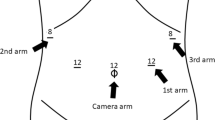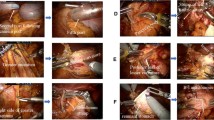Abstract
Background
Despite recent advances in robotic urological surgery, the feasibility and clinical merit of robotic gastric surgery have not yet been fully documented. Therefore, we designed a prospective, non-randomized study to determine the feasibility and safety of robot-assisted distal gastrectomy (RADG) for gastric cancer using electric cautery devices, which are more familiar to open surgery.
Methods
Between April 2010 and December 2012, 181 patients treated by distal gastrectomy for gastric carcinoma were eligible for this study. According to their intent to undergo uninsured robotic surgery, 21 patients were treated with RADG (RADG group) while 160 patients were treated by conventional laparoscopic distal gastrectomy (LDG group). Under a basic working hypothesis that the superior visualization and unique movement of the robotic arms during dissection would be closely associated with reduced amount of blood loss, even though an equivalent extension of lymph node dissection was carried out, we prospectively collected data from patients in the RADG and LDG groups.
Results
All patients were successfully treated without conversion except for one patient in the RADG group who underwent conversion to laparoscopic total gastrectomy. In comparison with the patient groups, the estimated blood loss in patients in the RADG group treated with electric cautery devices only was smaller, but not significantly, than patients in the LDG group treated with ultrasonic-activated devices, although the same extent of lymph node dissection was achieved. In contrast, there were four patients (2.5 %) in the LDG group who developed a pancreas fistula or intra-abdominal abscess, while no patients treated with RADG developed such complications.
Conclusions
RADG using electric cautery instruments without ultrasonic-activated devices is feasible and safe. The robot enables particular surgical views, called robotically-enhanced surgical anatomy, and may contribute to reducing blood loss despite the fact that only electric cautery was used.






Similar content being viewed by others
References
Hur H, Jeon HM, Kim W (2008) Laparoscopy-assisted distal gastrectomy with D2 lymphadenectomy for T2b advanced gastric cancers: three years’ experience. J Surg Oncol 98:515–519
Hwang SI, Kim HO, Yoo CH, Shin JH, Son BH (2009) Laparoscopic-assisted distal gastrectomy versus open distal gastrectomy for advanced gastric cancer. Surg Endosc 23:1252–1258
Noshiro H, Nagai E, Shimizu S, Uchiyama A, Tanaka M (2005) Laparoscopically assisted distal gastrectomy with standard radical lymph node dissection for gastric cancer. Surg Endosc 19:1592–1596
Kim MC, Jung GJ, Kim HH (2005) Learning curve of laparoscopy-assisted distal gastrectomy with systemic lymphadenectomy for early gastric cancer. World J Gastroenterol 11:7508–7511
Jin SH, Kim DY, Kim H, Jeong IH, Kim MW, Cho YK, Han SU (2007) Multidimensional learning curve in laparoscopy-assisted gastrectomy for early gastric cancer. Surg Endosc 21:28–33
Shinohara T, Satoh S, Kanaya S, Ishida Y, Taniguchi K, Isogaki J, Inaba K, Yanaga K, Uyama I (2013) Laparoscopic versus open D2 gastrectomy for advanced gastric cancer: a retrospective cohort study. Surg Endosc 27:286–294
Kanaya S, Haruta S, Kawamura Y, Yoshimura F, Inaba K, Hiramatsu Y, Ishida Y, Taniguchi K, Isogaki J, Uyama I (2010) Video: laparoscopy distinctive technique for suprapancreatic lymph node dissection: medial approach for laparoscopic gastric cancer surgery. Surg Endosc 25:3928–3929
Shinohara H, Kurahashi Y, Kanaya S, Haruta S, Ueno M, Udagawa H, Sakai Y (2013) Topographic anatomy and laparoscopic technique for dissection of no. 6 infrapyloric lymph nodes in gastric cancer surgery. Gastric Cancer 16(4):615–620
Hashizume M, Shimada M, Tomikawa M, Ikeda Y, Takahashi I, Abe R, Koga F, Gotoh N, Konishi K, Maehara S, Sugimachi K (2002) Early experiences of endoscopic procedures in general surgery assisted by a computer-enhanced surgeon system. Surg Endosc 16:1187–1191
Hanly EJ, Talamini MA (2004) Robotic abdominal surgery. Am J Surg 188:19S–26S
Baek SJ, Lee DW, Park SS, Kim SH (2011) Current status of robot-assisted gastric surgery. World J Gastrointest Oncol 3:137–143
Xiong B, Ma L, Zhang C (2012) Robotic versus laparoscopic gastrectomy for gastric cancer: a meta-analysis of short outcomes. Surg Oncol 21:274–280
Marano A, Hyung WJ (2012) Robotic gastrectomy: the current state of the art. J Gastric Cancer 12:63–72
Uyama I, Kanaya S, Ishida Y, Inaba K, Suda K, Satoh S (2012) Novel integrated robotic approach for suprapancreatic D2 nodal dissection for treating gastric cancer: technique and initial experience. World J Surg 36:331–337
Sano T, Aiko T (2011) New Japanese classifications and treatment guidelines for gastric cancer: revision concepts and major revised points. Gastric Cancer 14:97–100
Clavien PA, Barkun J, de Oliveira ML, Vauthey JN, Dindo D, Schulick RD, de Santibañes E, Pekolj J, Slankamenac K, Bassi C, Graf R, Vonlanthen R, Padbury R, Cameron JL, Makuuchi M (2009) The Clavien–Dindo classification of surgical complications: five-year experience. Ann Surg 250:187–196
Truesdale MD, Lee DJ, Cheetham PJ, Hruby GW, Turk AT, Badani KK (2010) Assessment of lymph node yield after pelvic lymph node dissection in men with prostate cancer: a comparison between robot-assisted radical prostatectomy and open radical prostatectomy in the modern era. J Endourol 24:1055–1060
Lee EK, Baack J, Duchene DA (2010) Survey of practicing urologists: robotic versus open radical prostatectomy. Can J Urol 17:5094–5098
Song J, Kang WH, Oh SJ, Hyung WJ, Choi SH, Noh SH (2009) Role of robotic gastrectomy using da Vinci system compared with laparoscopic gastrectomy: initial experience of 20 consecutive cases. Surg Endosc 23:1204–1211
Patriti A, Ceccarelli G, Bellochi R, Bartoli A, Spaziani A, Di Zitti L, Casciola L (2008) Robot-assisted laparoscopic total and partial gastric resection with D2 lymph node dissection for adenocarcinoma. Surg Endosc 22:2753–2760
Kim MC, Heo GU, Jung GJ (2010) Robotic gastrectomy for gastric cancer: surgical techniques and clinical merits. Surg Endosc 24:610–615
D’Annibale A, Pende V, Pernazza G, Monsellato I, Mazzocchi P, Lucandri G, Morpurgo E, Contardo T, Sovernigo G (2011) Full robotic gastrectomy with extended (D2) lymphadenectomy for gastric cancer: surgical technique and preliminary results. J Surg Res 166:e113–e120
Hotta T, Takifuji K, Yokoyama S, Matsuda K, Higashiguchi T, Tominaga T, Oku Y, Watanabe T, Nasu T, Hashimoto T, Tamura K, Ieda J, Yamamoto N, Iwamoto H, Yamaue H (2012) Literature review of the energy sources for performing laparoscopic colorectal surgery. World J Gastrointest Surg 4:1–8
Bodner J, Wykypiel H, Wetscher G, Schmid T (2004) First experiences with the da Vinci operating robot in thoracic surgery. Eur J Cardiothorac Surg 25:844–851
Pugliese R, Maggioni D, Sansonna F, Costanzi A, Ferrari GC, Di Lernia S, Magistro C, De Martini P, Pugliese F (2010) Subtotal gastrectomy with D2 dissection by minimally invasive surgery for distal adenocarcinoma of the stomach: results and 5-year survival. Surg Endosc 24:2594–2602
Kim MC, Heo GU, Jung GJ (2010) Robotic gastrectomy for gastric cancer: surgical techniques and clinical merits. Surg Endosc 24:610–615
Woo Y, Hyung WJ, Pak KH, Inaba K, Obama K, Choi SH, Noh SH (2011) Robotic gastrectomy as an oncologically sound alternative to laparoscopic resections for the treatment of early-stage gastric cancers. Arch Surg 146:1086–1092
Acknowledgments
The authors are grateful for the technical training and ongoing advice on the robotic procedures provided by Prof. Ichiro Uyama and Dr. Yoshinori Ishida at the Division of the Upper Gastrointestinal Tract of the Department of Surgery, Fujita Health University School of Medicine. We also thank Prof. Yoshiharu Sakai at the Division of the Gastrointestinal Tract of the Department of Surgery, Graduate School of Medical Sciences, Kyoto University, who coined the term robotically- (or robo-) enhanced surgical anatomy.
Disclosure
Hirokazu Noshiro, Osamu Ikeda, Masako Urata have no conflict of interest to declare.
Author information
Authors and Affiliations
Corresponding author
Rights and permissions
About this article
Cite this article
Noshiro, H., Ikeda, O. & Urata, M. Robotically-enhanced surgical anatomy enables surgeons to perform distal gastrectomy for gastric cancer using electric cautery devices alone. Surg Endosc 28, 1180–1187 (2014). https://doi.org/10.1007/s00464-013-3304-x
Received:
Accepted:
Published:
Issue Date:
DOI: https://doi.org/10.1007/s00464-013-3304-x




